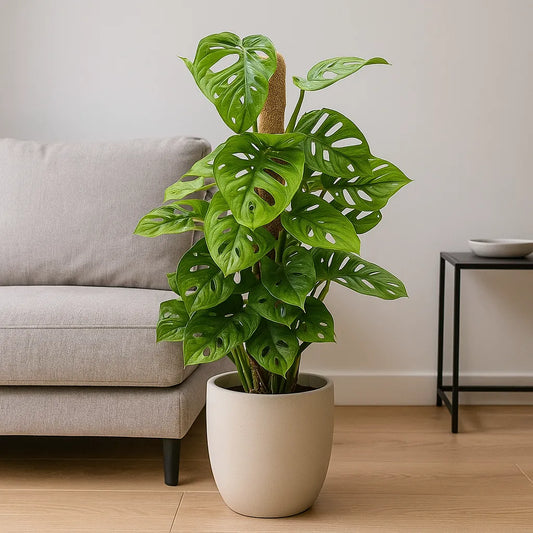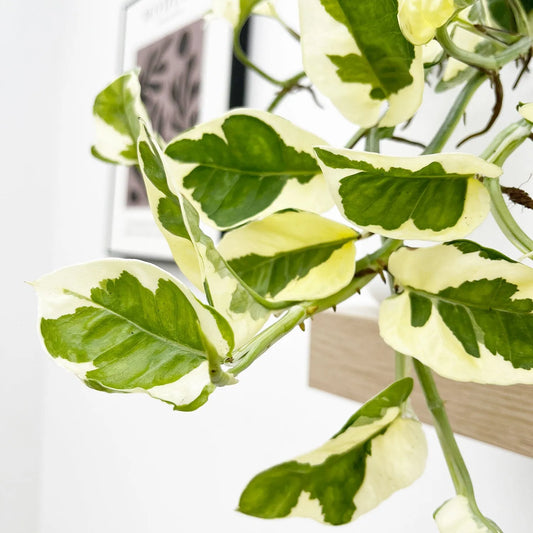How to propagate Philodendron
Philodendrons are easy to grow, popular houseplants that thrive in indoor conditions, making them a fantastic choice for beginner house plant owners. Their heart-shaped leaves have a glossy sheen that adds colour and light to your space, whilst their thin, trailing stems add texture and fill the space.
These plants are easy to love and quickly become a favourite amongst plant enthusiasts. They can also be propagated from a simple stem cutting or division so you can enjoy even more new plants as you tame your existing Philodendrons.
There are a few different ways to propagate your Philodendron plants so we’ll have a look in more detail in this guide.
How to propagate Philodendron from cuttings
Taking a cutting from a Philodendron is an easy and effective way to propagate new plants, and whilst it can seem complicated if you haven’t done it before, it’s an easy way to propagate indoor plants. Using cuttings as an easy way to propagate new plants and is suitable for upright Philodendron varieties such as the Philodendron Hederaceum or Philodendron Lemon Lime
What is a Philodendron cutting?
A stem cutting involves cutting off part of your Philodendron at the stem and propagate it in water so you can replant it and grow a new plant. Doing this creates a clone of the original plant called offsets. These offsets will look like your original plant and will allow you to grow your collection and enjoy the plant without buying a brand new plant.
When to take Philodendron cuttings
You should start propagating Philodendrons in early spring (ideally around March). This will give your new plant the best lighting conditions to grow into a healthy and hardy plant. You can propagate your plant later on in the year, but the chances of the division dying are much higher.
How to take a Philodendron cutting
Propagating your Philodendron through a cutting only takes a few steps to get great results. To make a cutting, you will need a small knife or pair of scissors, a small container of potting soil or a jug of water.
-
Choose where you will cut - Choosing the right part of your plant to take your cutting is an essential first step. The health of the cutting will have a significant effect on the health of your new plant. You want to choose an older stem with a tougher, woodier stem. Your chosen stem should be a uniform colour, without any discolouration; the leaves should be glossy and unblemished. If you are making a cutting of a variegated Philodendron, make sure the variegation is an even colour with no yellowing.
-
Take your cutting - The roots of a Philodendron cutting will grow from the bottom of a piece of stem. A healthy Philodendron will have lots of smaller shoots growing from the main branches at points called nodes. You want to make a clean cut along the node to have a section about 4 to 6 inches (10 to 15cm) long. If possible, you should take multiple cuttings, but don’t over cut, or you will damage your original plant.
-
Snip off any excess leaves or stems - Once you have your cutting, you will need to clean it up so that it grows properly. Remove smaller leaves and stems from the cutting carefully until you are left with one stem and two to three leaves. The part of the cutting you are planning to plant should be undamaged and free of any growth, or they will rot.
How to grow a Philodendron cutting
Propagating in soil - Stem cuttings need to be grown in suitable soil. The ideal propagation medium for Philodendron cutting should be a well-draining and moist potting soil mixed with perlite or vermiculite. Adding these to the mix will create a light propagation medium that will allow the young root system. You can also give your young plant a boost by adding rooting hormone into the soil (you can buy this from any good garden centre); just make sure to follow the packaging instructions very carefully to avoid killing your plant. Put your propagation medium into a small pot, making sure not to press down too much.
Water the soil well to moisten it and insert the cutting deeply into the soil to secure it. Young plants cannot regulate their moisture intake, so cover your pot with plastic that the air can flow through and leave in a windowsill that is warm and receives indirect sunlight throughout the day. After four weeks, gently tug your cuttings to check if the roots are growing. If you feel resistance from the plant, then it has formed roots.
Propagating in water - Place your cutting in a clean glass or bottle of water, and place it in a windowsill that receives partial sun throughout the day. Change the water every three to five days, making sure only to use room temperature water to avoid shocking your plant. It will take about two months for the root system to develop.
Transplant your Philodendron cutting - Once you have a strong root system, it’s time to plant your cutting in a pot. Prepare a pot with well-draining soil and leave about an inch or two of space from where you want the final soil level. Gently remove the cutting from its propagation tray or glass, careful not to damage or tear the roots.
Place the cutting and rootball on the soil and slowly pile the rest around it until covered. Press down gently and water well.
How to propagate Philodendron by dividing
Dividing an overgrown or mature Philodendron is a great way to gain more plants. Each section will its own established root system so new growth will appear within days and your new plant has a good chance of surviving.
If you want to divide your Philodendron, water it thoroughly to moisten and loosen the soil the morning before. This will make it much easier to divide the plant and provides your plant with plenty of moisture to help it survive the stress of being transplanted.
Take the plant out of its container and gently divide the roots into two or more sections, ensuring each section has at least two roots. Replant your main plant into its original container and set the other sections aside, ready to be replanted.
Transplanting Philodendrons
Philodendrons like to be planted in loose, well-draining soil high in organic matter.
When you’re ready to replant your divisions, fill the pot up to three quarters full, position your division into the pot and spread the roots out into the soil. Fill in around the roots with soil and pat the soil down with your hands to secure the plant.
Put these new plants in a spot in your home that receives plenty of bright, indirect sunlight and avoid direct sunlight to make sure your plants do not get sunburnt.
Take a look at our full range of Philodendron plants.











Leave a comment
Please note, comments need to be approved before they are published.